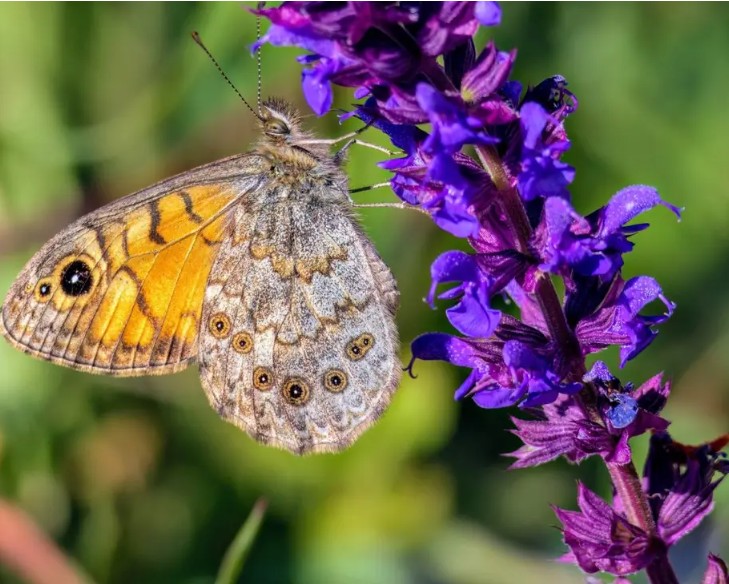 |
|
(De Agostini Picture Library/Getty Images)
|
Full Story: Earth (6/24)

Butterflies can adapt quickly – but evolution has its limits
As Earth’s temperature rises, nature begins to shift. Butterflies, along with many animals and plants, now move north into places that were once too cold. Scientists are closely watching this trend to see how evolution shapes these movements – and where it might fall short.
A new study focuses on wall brown butterflies, which offer big clues about the role of evolution in climate-driven movement. Researchers wanted to know how much change the species could manage on its own
Butterflies adapt as they move north
The wall brown (Lasiommata megera) is a grassland butterfly found across Europe. In recent decades, it has become more common in parts of Scandinavia. Yet it has declined sharply in Western Europe.
The butterfly’s success in the north is not random. It has changed its life cycle to suit longer days and different seasonal patterns.
Mats Ittonen is one of the lead authors of the study, which was conducted by researchers in the Department of Zoology at Stockholm University.
“Our results show that even though the butterflies adapt their life cycle as they move northwards, there are limits that evolution cannot easily overcome,” said Ittonen.
Evolution seems to help the species match new environments. In particular, it allows the butterfly to respond to cues that remain steady, like the number of daylight hours.
These cues are important because they guide dormancy and development. Still, not everything can change easily. Winters in northern regions continue to block further movement.
Does evolution help butterflies survive?
To explore how the wall brown has changed over time, the researchers carried out detailed field experiments. They collected butterflies from both southern and northern parts of Sweden.
The southern group came from Skåne county. The northern group came from Södermanland and Uppland counties. Then, they placed the butterflies in cages in three places: Skåne, Södermanland, and southern Dalarna.
The goal was to see how each group fared when exposed to identical environmental conditions.
Dalarna sits just beyond the species’ current northern range. If butterflies from northern populations could survive there, it would suggest they had evolved better survival traits. The study looked at growth rate, timing of winter dormancy, and survival through the cold months.
“We wanted to know whether traits like faster growth, properly timed winter dormancy, and improved winter survival have evolved in northern butterflies, traits that could help them establish even further north,” said Professor Karl Gotthard.
Evolution improved some butterfly traits
The findings showed that northern caterpillars did indeed grow faster. Summers are shorter in higher latitudes, so a quicker life cycle helps. They also entered dormancy at the right time.
But these advantages did not translate into long-term survival. When winter came, the caterpillars in Dalarna struggled. Most did not make it.
The researchers concluded that even though evolution had helped improve some of the butterfly’s traits, it had not yet solved the problem of cold resistance.
Insects need more than just good timing and growth to thrive through northern winters. Without traits that guard against extreme cold, they simply cannot expand further.
“These kinds of limits are important to recognize if we want to predict how far north other species, including pests and disease vectors, will be able to move in a future climate,” said Professor Gotthard.
The reality of environmental pressures
This study reveals something important about climate adaptation. Evolution can move quickly in insects, but it doesn’t always improve the right traits.
Speed and timing matter, but without the ability to survive freezing temperatures, further expansion becomes impossible. Warmer summers help, but they do not guarantee success unless winters also become milder.
The butterflies serve as a reminder that not all environmental pressures can be overcome easily. Natural selection works with what’s available.
If key genes for cold tolerance are rare or slow to spread, progress will stall. That seems to be the case with the wall brown butterfly. It has changed, but not enough.
What this means for other species
Many insect species have shifted their ranges in the past few decades. Sweden, in particular, has seen a steady rise in insect diversity further north. But each species carries its own set of traits and limits. What works for one may not work for another.
“The wall brown is far from alone. Many other insect species have also expanded northward over the past few decades, both in Sweden and elsewhere,” said Ittonen.
“Understanding both which traits evolve and which ones actually set the limits for where species can live is essential for predicting the future of ecosystems and biodiversity in a warming world.”
If winters remain harsh, many species will hit similar boundaries. Their success will depend not just on temperature trends, but on how fast and in what direction evolution works.
Predicting this will require close studies like this one, where fieldwork meets biology to trace nature’s next move.
Watching the edges of change
The story of evolution in wall brown butterflies shows how nature reacts to climate change in small, careful steps. Evolution offers a path forward, but it is not a magic key. Cold winters still act as a wall.
As climate change continues, scientists must ask not only if species can adapt, but whether those adaptations come in time.
For the wall brown and many others, survival at the edge depends not just on warming trends but also on biological timing, hidden traits, and chance.
The cold sets a limit. And evolution, though powerful, sometimes stops short of breaking through.




